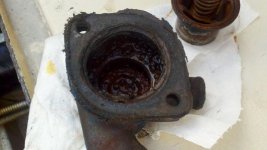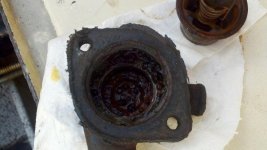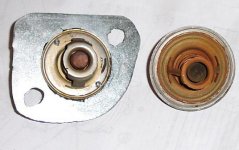My stbd motor (RWC) has a 1974 "top hat" style thermostat and housing. The motor can't seem to get to normal operating temperature, even after 30-45 minutes at 2500 RPM. The manifolds and risers reach just over 100 degrees, but the intake manifold (near the temp sender) barely reaches 100.
I removed the housing and thermostat to inspect. The thermostat is not stuck in the open position, and I noticed that when the thermostat is seated in the housing, there is actually a gap the top of the thermostat body and inner surface of the housing. Therefore, even if the thermostat is closed, water can still flow through this gap, down the inside of the thermostat body, and into the engine block.
I am under the impression that there should be some type of seal on the inside of the housing which allows the thermostat body to "seat" into and create a water tight seal. I've attached some images if anyone cares to look.
Any suggestions?
-JJ

I removed the housing and thermostat to inspect. The thermostat is not stuck in the open position, and I noticed that when the thermostat is seated in the housing, there is actually a gap the top of the thermostat body and inner surface of the housing. Therefore, even if the thermostat is closed, water can still flow through this gap, down the inside of the thermostat body, and into the engine block.
I am under the impression that there should be some type of seal on the inside of the housing which allows the thermostat body to "seat" into and create a water tight seal. I've attached some images if anyone cares to look.
Any suggestions?
-JJ




